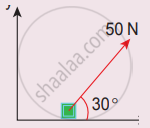Advertisements
Advertisements
प्रश्न
Choose the correct answer.
For which of the following objects will the center of mass not be at their geometrical center?
(I) An egg
(II) a cylindrical box full of rice
(III) a cubical box containing assorted sweets
विकल्प
Only (I)
Only (I) and (II)
Only (III)
All (I), (II), and (III)
उत्तर
All (I), (II), and (III)
APPEARS IN
संबंधित प्रश्न
Choose the correct answer.
Consider the following pair of forces of equal magnitude and opposite directions:
P. Gravitational forces exerted on each other by two-point masses separated by a distance.
Q. Couple of forces used to rotate a water tap.
R. Gravitational force and normal force experienced by an object kept on a table.
For which of these pair/pairs the two forces do not cancel each other’s translational effect?
Choose the correct answer.
Consider following forces: (w) Force due to tension along a string, (x) Normal force given by a surface, (y) Force due to air resistance, and (z) Buoyant force or upthrust given by a fluid.
Which of these are electromagnetic forces?
Choose the correct answer.
At a given instant three-point masses m, 2m and 3m are equidistant from each other. Consider only the gravitational forces between them. Select correct statement/s for this instance only:
Choose the correct answer.
The rough surface of a horizontal table offers a definite maximum opposing force to initiate the motion of a block along with the table, which is proportional to the resultant normal force given by the table. Forces F1 and F2 act at the same angle T with the horizontal and both are just initiating the sliding motion of the block along with the table. Force F1 is a pulling force while the force F2 is a pushing force. F2 > F1, because
A mass 2 m moving with some speed is directly approaching another mass m moving with double speed. After some time, they collide with a coefficient of restitution of 0.5. The ratio of their respective speeds after the collision is ______.
Choose the correct answer.
Select the wrong statement about the centre of mass:
A vehicle is moving along the positive x-direction, if a sudden brake is applied, then ______
Two masses m1 and m2 are experiencing the same force where m1 < m2. The ratio of their acceleration `a_1/a_2` is ______
Choose an appropriate free body diagram for the particle experiencing net acceleration along the negative y-direction. (Each arrow mark represents the force acting on the system).
A particle of mass m sliding on the smooth double inclined plane (shown in the figure) will experience ______

A force of 50N acts on the object of mass of 20 kg. shown in the figure. Calculate the acceleration of the object in x and y directions.

A stone of mass 2 kg is attached to a string of length 1 meter. The string can withstand a maximum tension of 200 N. What is the maximum speed that stone can have during the whirling motion?
What is the reading shown in spring balance?

A bomb at rest explodes into 3 parts of the same mass. The momentum of the two parts is `-2"P"hat"i"` and `4"P"hat"J"` respectively. The magnitude of the momentum of the third part is ______
A block of mass Mis pulled along a smooth horizontal surface with a rope of mass m by force F. The acceleration of the block will be ______.
A body of mass M at rest explodes into three pieces, in the ratio of masses 1:1:2. Two smaller pieces fly off perpendicular to each other with velocities of 30 ms-1 and 40 ms-1 respectively. The velocity of the third piece will be:
A wire of length L is hanging from a fixed support. The length changes to L1 and L2 when masses 1 kg and 2 kg are suspended respectively from its free end. Then the value of L is equal to :
A block of mass 40 kg slides over a surface when a mass of 4 kg is suspended through an inextensible massless string passing over a frictionless pulley as shown below. The coefficient of kinetic friction between the surface and block is 0.02. The acceleration of the block is ______.
(Given g = 10 ms-2.)

A steel block of 10 kg rests on a horizontal floor as shown. When three iron cylinders are placed on it as shown, the block and cylinders go down with an acceleration of 0.2 m/s2. The normal reaction R' by the floor if the mass of the iron cylinders is equal and of 20 kg each, is ______.
[take g = 10 m/s2 and µs = 0.2]

